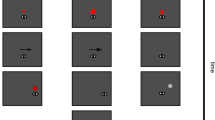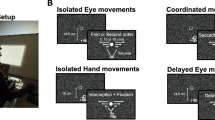Abstract
When participants reach for a target, their hand can adjust to a change in target position that occurs while their eyes are in motion (the hand’s automatic pilot) even though they are not aware of the target’s displacement (saccadic suppression of perceptual experience). However, previous studies of this effect have displayed the target without interruption, such that the new target position remains visible during the fixation that follows the saccade. Here we test whether a change in target position that begins and ends during the saccade can be used to update aiming movements. We also ask whether such information can be acquired from two targets at a time. The results showed that participants responded to single and double target jumps even when these targets were extinguished prior to saccade termination. The results imply that the hand’s automatic pilot is updated with new visual information even when the eye is in motion.






Similar content being viewed by others
Notes
Even when jumps are perceptually accessible and participants are instructed to stop their movement (Pisella et al. 2000; Cressman et al. 2006) or to point in the opposite direction (Day and Lyon 2000) if the target moves, people fail to inhibit a deviation toward the displaced target. Recent evidence from our laboratory does suggest, however, that automaticity can be reduced by instructions that downplay the relevance of the target jump to the task, such as when people are told to ignore the jump (Cameron et al. 2009).
We note that this is a higher percentage of jump trials (50%) than was employed by Pisella et al. (2000) (20%) and closer to the percentage employed by Prablanc and Martin (1992) (66%). Unlike Pisella et al.’s experiment, the target perturbation in our experiment was paired with the saccade, which removes awareness of the jump. In this way, our study is more similar to Prablanc and Martin’s (1992). We would expect this lack of awareness to prevent any influence of the proportion of jump trials on a participant’s explicit strategy (though there is always the possibility that the nature and frequency of target perturbations might have an implicit effect on a participant’s performance).
In Experiment 1, average saccade MT was 72.9 ms (SD: 8.16 ms). Average time of the jump was 35.4 ms (SD: 7.25 ms) after the start of the saccade. Therefore, on average, the target disappeared 55.4 ms into the saccade, or 17.5 ms prior to the completion of the saccade.
We note that EOG was sufficient for Prablanc and Martin (1992) to detect an influence of their larger target jump on saccade amplitude, suggesting that this methodology does not preclude detection of an online response when such a response is present, though it may only detect the effect when the jump is large.
Two kinds of forward jump were included in an attempt to match the backward jump in both the initial target position (position 4) and the region traversed by the jump (between positions 3 and 4).
Given the high velocity of the eyes during a saccade, however, one would certainly expect post-saccadic information to be more reliable.
These are (1) suppression of a flashed stimulus, (2) suppression of continuous motion, and (3) suppression of a discrete displacement (i.e., a jump) (MacAskill et al. 2003).
References
Baldauf D, Wolf M, Deubel H (2006) Deployment of visual attention before sequences of goal-directed hand movements. Vision Res 46:4355–4374
Bridgeman B, Hendry D, Stark L (1975) Failure to detect displacement of the visual world during saccadic eye movements. Vision Res 15:719–722
Bridgeman B, Lewis S, Heit G, Nagle M (1979) Relation between cognitive and motor-oriented systems of visual position perception. J Exp Psychol Hum Percept Perform 5:692–700
Burr DC, Morrone MC, Ross J (1994) Selective suppression of the magnocellular visual pathway during saccadic eye movements. Nature 371:511–513
Cameron BD, Cressman EK, Franks IM, Chua R (2009) Cognitive constraint on the ‘automatic pilot’ for the hand: movement intention influences the hand’s susceptibility to involuntary online corrections. Conscious Cogn (in press)
Cameron BD, Franks IM, Enns JT, Chua R (2007) Dual-target interference for the ‘automatic pilot’ in the dorsal stream. Exp Brain Res 181:297–305
Chamberlin CJ, Magill RA (1989) Preparation and control of rapid, multisegmented responses in simple and choice environments. Res Q Exerc Sport 60:256–267
Chen-Harris H, Joiner WM, Ehier V, Zee DS, Shadmehr R (2008) Adaptive control of saccades via internal feedback. J Neurosci 28:2804–2813
Cressman EK, Franks IM, Enns JT, Chua R (2006) No automatic pilot for visually guided aiming based on colour. Exp Brain Res 171:174–183
Day BL, Lyon IN (2000) Voluntary modification of automatic arm movements evoked by motion of a visual target. Exp Brain Res 130:159–168
Desmurget M, Grafton S (2000) Forward modeling allows feedback control for fast reaching movements. Trends Cogn Sci 4:423–431
Desmurget M, Gaveau V, Vindras P, Turner RS, Broussolle E, Thobois S (2004) On-line motor control in patients with Parkinson’s disease. Brain 127:1755–1773
Desmurget M, Turner RS, Prablanc C, Russo GS, Alexander GE, Grafton ST (2005) Updating target location at the end of an orienting saccade affects the characteristics of simple point-to-point movements. J Exp Psychol Hum Percept 31:1510–1536
Gaveau V, Martin O, Prablanc C, Pelisson D, Urquizar C, Desmurget M (2003) On-line modification of saccadic eye movements by retinal signals. Neuroreport 14:875–878
Goodale MA, Pelisson D, Prablanc C (1986) Large adjustments in visually guided reaching do not depend on vision of the hand or perception of target displacement. Nature 320:748–750
Gribble PL, Everling S, Ford K, Mattar A (2002) Hand-eye coordination for rapid pointing movements: arm movement direction and distance are specified prior to saccade onset. Exp Brain Res 145:372–382
MacAskill M, Jones R, Anderson T (2003) Saccadic suppression of displacement: effects of illumination and background manipulation. Perception 32:463–474
Neggers SF, Bekkering H (2000) Ocular gaze is anchored to the target of an ongoing pointing movement. J Neurophysiol 83:639–651
Neggers SF, Bekkering H (2001) Gaze anchoring to a pointing target is present during the entire pointing movement and is driven by a non-visual signal. J Neurophysiol 86:961–970
Pisella L, Grea H, Tilikete C, Vighetto A, Desmurget M, Rode G, Boisson D, Rossetti Y (2000) An “automatic pilot” for the hand in human posterior parietal cortex: toward reinterpreting optic ataxia. Nat Neurosci 3:729–736
Prablanc C, Martin O (1992) Automatic control during hand reaching at undetected two-dimensional target displacements. J Neurphysiol 67:455–469
Prablanc C, Pelisson D, Goodale MA (1986) Visual control of reaching movements without vision of the limb: I. Role of retinal feedback of target position in guiding the hand. Exp Brain Res 62:293–302
Whitney D, Westwood DA, Goodale MA (2003) The influence of visual motion on fast reaching movements to a stationary object. Nature 423:869–873
Acknowledgments
This research was supported by a scholarship from the Natural Sciences and Engineering Research Council of Canada (NSERC) awarded to B.C. and by a NSERC Discovery Grant awarded to R.C. We thank Dr. James Danckert and an anonymous reviewer for helpful comments on the manuscript.
Author information
Authors and Affiliations
Corresponding author
Rights and permissions
About this article
Cite this article
Cameron, B.D., Enns, J.T., Franks, I.M. et al. The hand’s automatic pilot can update visual information while the eye is in motion. Exp Brain Res 195, 445–454 (2009). https://doi.org/10.1007/s00221-009-1812-7
Received:
Accepted:
Published:
Issue Date:
DOI: https://doi.org/10.1007/s00221-009-1812-7




